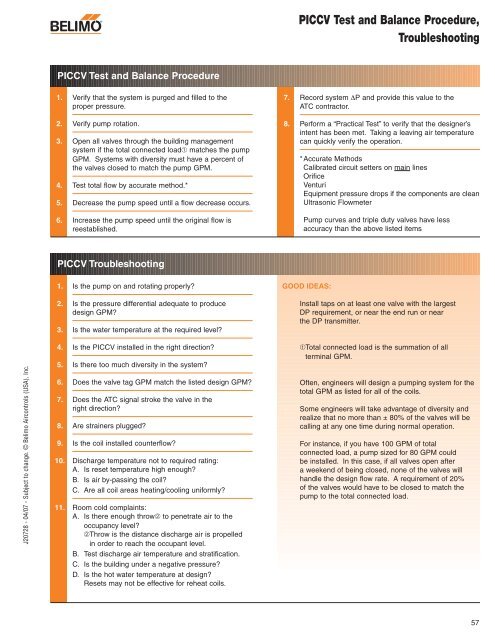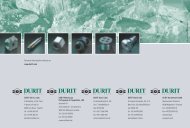Technical Documentation Pressure Independent Characterized ...
Technical Documentation Pressure Independent Characterized ...
Technical Documentation Pressure Independent Characterized ...
Create successful ePaper yourself
Turn your PDF publications into a flip-book with our unique Google optimized e-Paper software.
J20728 - 04/07 - Subject to change. © Belimo Aircontrols (USA), Inc.<br />
1. Verify that the system is purged and filled to the<br />
proper pressure.<br />
2. Verify pump rotation.<br />
® PICCV<br />
PICCV Test and Balance Procedure<br />
3. Open all valves through the building management<br />
system if the total connected load➀ matches the pump<br />
GPM. Systems with diversity must have a percent of<br />
the valves closed to match the pump GPM.<br />
4. Test total flow by accurate method.*<br />
5. Decrease the pump speed until a flow decrease occurs.<br />
6. Increase the pump speed until the original flow is<br />
reestablished.<br />
PICCV Troubleshooting<br />
1. Is the pump on and rotating properly?<br />
2. Is the pressure differential adequate to produce<br />
design GPM?<br />
3. Is the water temperature at the required level?<br />
4. Is the PICCV installed in the right direction?<br />
5. Is there too much diversity in the system?<br />
6. Does the valve tag GPM match the listed design GPM?<br />
7. Does the ATC signal stroke the valve in the<br />
right direction?<br />
8. Are strainers plugged?<br />
9. Is the coil installed counterflow?<br />
10. Discharge temperature not to required rating:<br />
A. Is reset temperature high enough?<br />
B. Is air by-passing the coil?<br />
C. Are all coil areas heating/cooling uniformly?<br />
11. Room cold complaints:<br />
A. Is there enough throw➁ to penetrate air to the<br />
occupancy level?<br />
➁Throw is the distance discharge air is propelled<br />
in order to reach the occupant level.<br />
B. Test discharge air temperature and stratification.<br />
C. Is the building under a negative pressure?<br />
D. Is the hot water temperature at design?<br />
Resets may not be effective for reheat coils.<br />
Test and Balance Procedure,<br />
Troubleshooting<br />
7. Record system ΔP and provide this value to the<br />
ATC contractor.<br />
8. Perform a “Practical Test” to verify that the designer’s<br />
intent has been met. Taking a leaving air temperature<br />
can quickly verify the operation.<br />
*Accurate Methods<br />
Calibrated circuit setters on main lines<br />
Orifice<br />
Venturi<br />
Equipment pressure drops if the components are clean<br />
Ultrasonic Flowmeter<br />
Pump curves and triple duty valves have less<br />
accuracy than the above listed items<br />
GOOD IDEAS:<br />
Install taps on at least one valve with the largest<br />
DP requirement, or near the end run or near<br />
the DP transmitter.<br />
➀Total connected load is the summation of all<br />
terminal GPM.<br />
Often, engineers will design a pumping system for the<br />
total GPM as listed for all of the coils.<br />
Some engineers will take advantage of diversity and<br />
realize that no more than ± 80% of the valves will be<br />
calling at any one time during normal operation.<br />
For instance, if you have 100 GPM of total<br />
connected load, a pump sized for 80 GPM could<br />
be installed. In this case, if all valves open after<br />
a weekend of being closed, none of the valves will<br />
handle the design flow rate. A requirement of 20%<br />
of the valves would have to be closed to match the<br />
pump to the total connected load.<br />
57




